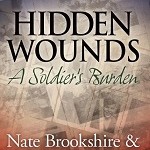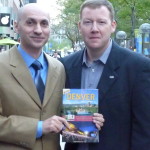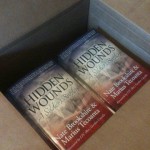Lessons in the marketplace were the unanticipated deliverables in the boxes of their own books. They arrived fresh off the presses onto the door steps of co-authors, Marius Tecoanta and Nate Brookshire.
 WoW – Words on Wednesdays will ultimately visit the PROCESS of publishing – the battles waged to get military writers’ words to their audiences successfully. Today, we’ll continue with the CREATIVE process, in our coverage of Military writers, cartoonists, essayists, authors and bloggers…
WoW – Words on Wednesdays will ultimately visit the PROCESS of publishing – the battles waged to get military writers’ words to their audiences successfully. Today, we’ll continue with the CREATIVE process, in our coverage of Military writers, cartoonists, essayists, authors and bloggers…
Your nominations for future posts are welcome!
Now, it’s (this) editor’s choice. Getting this book out is what brought the three of us, Helena, Marius and Nate together-to tell a story of two families. Our growth as a team and understanding of the scope of the subject grew into a new mission.
We knew we wanted to create more space for the critical stories of our time, told by and for others. Stories of transformation and of resilience lived by military members in transition back to their civilian life, possibly new work and studies and to their family life.
“Marius Tecoanta’s first work of historical fiction, co-authored with Nate Brookshire launched on Nov 15, 2011. Hidden Wounds: A Soldier’s Burden was a timely and very readable book that addressed the lingering issues that affect soldiers and their families. It was a fictional account, set across decades and countries.
Through the evolving trust, time and stories shared between editor and writer(s), the true life and personal biographical bits became evident. The story was no less powerful for knowing the behind the scenes stuff.
I read it 6 or maybe 8 times to do my job – to take the work of ‘accidental novelists’ and shape it. I still cried. You’ll be impacted too. Maybe at different parts, for different reasons.
Marius Tecoanta, with his strong European origins and knowledge of Romanian, English and German wrote the German protagonist’s perspective in WWII. Nate Brookshire outlined the American story.
The book’s working title was Eagle/Adler to represent both nations’ iconic and powerful symbols of eagles. Their book goes beyond patriotism.
“We wanted to show the human face of war,” says Tecoanta. “Fight a good cause, but you fight it by the rules. It was important for me to express that there is goodness in each nation and in each person.”
He drew on a compendium of interviews and testimonials from WWII Veterans he had gathered. That work was in pursuit of a Master’s Degree online in Military History with the American Military University in Virginia.
Their passionate project on the plight of soldiers would not take real root till “Marius put my feet to the fire” as Brookshire says.
“We went our separate ways at the conclusion of OCS in 2004, but always kept in touch,” says Tecoanta. The friends and now ‘brothers’ came face to face again at a course in Ft. Jackson. It re-ignited their need to make their conversations materialize and it sparked the writing of the first chapter.
It was a difficult step towards a journey with many unexpected personal and professional twists in their lives.
“History is made by people,” said Tecoanta. “My goal was to represent a soldier in any army who is faced with violence, conflict and acts of cruelty. To show how split second decisions affect a person’s life. How they cope with it.”
Events shape those people and Tecoanta wrote battle and geographic scenes faithfully from his in person visits, interviews and research. “All information about the units, divisions and action, including one of the most horrendous wipe outs in battle are accurate,” says Tecoanta.
“In Rudy Haas, our complex German hero’s life and experience is completely fictional but based on numerous real characters.” Sadly, as a necessity to fuel the long-term struggle of John Dougall, the American soldier, Tecoanta chose to kill off his creation. Readers have said they feel a similar sorrow at the death of his well crafted fictional friend.
In the compassion for the “everyman” deployed soldier, Tecoanta agreed with co-author Brookshire on another decision. The co-writers would try to shield their American soldier protagonist from evil and guilt by letting another character initiate those actions.
Tecoanta continues, “As in life, our honest person simply didn’t react and then he bore that regret for a lifetime that set him on the path to redemption.”
Creative license applies to the characters. Many are composites of real life mentors, neighbors and even former girl friends whose real life war time experience inspired the profiles of the story’s women.
“Action scenes were placed in towns I visited and photographed. Some descriptions were enriched by the drawings I studied in propaganda posters for wardrobe, architecture and scenery detail,” says Marius, the meticulous analyzer of material.
“I also read accounts of life. There is no fantasy in this historical fiction, it is meant to be realistic and credible. People really did do all those things in those places, even an improbable escape from East to West Berlin by underground U-Bahn tunnels.
Loyalty is a recurring theme in Tecoanta’s writing. It stems from his values of long-term commitments to family and friendships. These important elements of life are found in his writing and his second life as author and officer in the US Military.
Tecoanta and Brookshire earmarked proceeds from the book to assist hiddenwounds.org. The authors chose to support that organization after discovering its similarity in name and mission to the book title they had already chosen. Their conscious goal was to help push it to national status and included the “.org” in their resources pages. They had in common the work of helping returning service men and women challenged with Post Traumatic Stress and other issues.
The book, however, as you’ll discover, offers not only a compassionate look at the origins of PTSD in one set of families. It shines a light on families and the strength of women in military families. It also paints the sweeping vistas of magnificent locations that are the backdrop to war.
Original draft of the back cover:
April 13, 1945….The last days of WWII… Eight lone German soldiers surrendered. Instead of a POW camp their steps took them into a shallow grave.
John Dougall, an 18-year-old American soldier stood by as the murderous shots were fired. Laying there among the dead was Rudolph Haas, an officer whose death would burden John for a life time.
He sought redemption in the rugged hills of Korea and in the swamps of Vietnam. Chaining him to remorse and guilt were the private thoughts of Haas, written carefully into the diary that John had taken from the German’s body.
Six decades later, fate gave John one last chance to set things right and make peace with his past.
![]() Helena Kaufman is the managing editor of MilSuccessNet AKA: Military Success Network. She has specialized in writing business and cultural content for 32 years. With thousands of her pieces both in print and circulating online, and almost 10 books edited for others, she’s finally planning her own book in the summer of 2013.
Helena Kaufman is the managing editor of MilSuccessNet AKA: Military Success Network. She has specialized in writing business and cultural content for 32 years. With thousands of her pieces both in print and circulating online, and almost 10 books edited for others, she’s finally planning her own book in the summer of 2013.
Transition, reinvention and the pursuit of resiliency is built into her work and life choices. At least one hopes. And then one…redrafts.
SUBSCRIBE now and get 1st Alerts on articles so you don’t miss out.


This is an amazing book with raw honesty that can be appreciated by both combat veterans and those seeking to better understand their plight. Nate, thank you for writing such a meaningful and powerful book for us to embrace. Shaun.